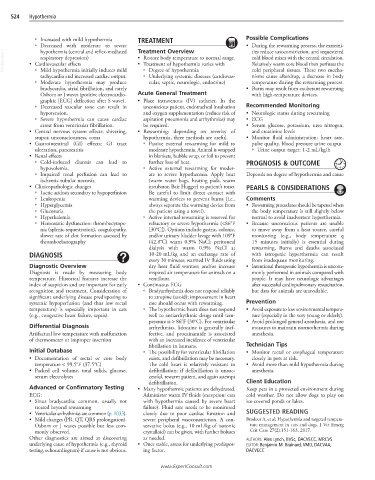Page 1060 - Cote clinical veterinary advisor dogs and cats 4th
P. 1060
524 Hypothermia
○ Increased with mild hypothermia TREATMENT Possible Complications
○ Decreased with moderate to severe Treatment Overview • During the rewarming process, the extremi-
VetBooks.ir • Cardiovascular effects • Restore body temperature to normal range. cold blood mixes with the central circulation.
ties reduce vasoconstriction, and sequestered
hypothermia (central and reflex-mediated
respiratory depression)
• Treatment of hypothermia varies with
Relatively warm core blood then perfuses the
○ Mild hypothermia initially induces mild
tachycardia and increased cardiac output. ○ Degree of hypothermia cold peripheral tissues. These two mecha-
nisms cause afterdrop, a decrease in body
○ Underlying systemic diseases (cardiovas-
○ Moderate hypothermia may produce cular, septic, neurologic, endocrine) temperature during the rewarming process.
bradycardia, atrial fibrillation, and rarely • Burns may result from exuberant rewarming
Osborn or J waves (positive electrocardio- Acute General Treatment with high-temperature devices.
graphic [ECG] deflection after S wave). • Place intravenous (IV) catheter. In the
○ Decreased vascular tone can result in unconscious patient, endotracheal intubation Recommended Monitoring
hypotension. and oxygen supplementation (reduce risk of • Neurologic status during rewarming
○ Severe hypothermia can cause cardiac aspiration pneumonia and arrhythmias) may • ECG
arrest from ventricular fibrillation. be required. • Serum glucose, potassium, urea nitrogen,
• Central nervous system effects: shivering, • Rewarming: depending on severity of and creatinine levels
stupor, unconsciousness, coma hypothermia, three methods are useful. • Monitor fluid administration: heart rate,
• Gastrointestinal (GI) effects: GI tract ○ Passive external rewarming for mild to pulse quality, blood pressure urine output
ulceration, pancreatitis moderate hypothermia. Animal is wrapped ○ Urine output target: 1-2 mL/kg/h
• Renal effects in blankets, bubble wrap, or foil to prevent
○ Cold-induced diuresis can lead to further loss of heat. PROGNOSIS & OUTCOME
hypovolemia. ○ Active external rewarming for moder-
○ Impaired renal perfusion can lead to ate to severe hypothermia. Apply heat Depends on degree of hypothermia and cause
ischemic tubular necrosis. (warm water bags, heating pads, warm
• Clinicopathologic changes incubator, Bair Hugger) to patient’s torso. PEARLS & CONSIDERATIONS
○ Lactic acidosis secondary to hypoperfusion Be careful to limit direct contact with
○ Leukopenia warming devices to prevent burns (i.e., Comments
○ Hyperglycemia always separate the warming device from • Rewarming procedures should be tapered when
○ Glucosuria the patient using a towel). the body temperature is still slightly below
○ Hyperkalemia ○ Active internal rewarming is reserved for normal to avoid inadvertent hyperthermia.
○ Hemostatic dysfunction: thrombocytope- refractory or severe hypothermia (<86°F • Because unconscious patients are unable
nia (splenic sequestration), coagulopathy, [30°C]). Options include gastric, colonic, to move away from a heat source, careful
slower rate of clot formation assessed by and/or urinary bladder lavage with 109°F monitoring (e.g., body temperature q
thromboelastography (42.8°C) warm 0.9% NaCl; peritoneal 15 minutes initially) is essential during
dialysis with warm 0.9% NaCl at rewarming. Burns and deaths associated
DIAGNOSIS 10-20 mL/kg and an exchange rate of with iatrogenic hyperthermia can result
every 30 minutes; warmed IV fluids using from inadequate monitoring.
Diagnostic Overview dry heat fluid warmer; and/or increase • Intentional therapeutic hypothermia is uncom-
Diagnosis is made by measuring body inspired air temperature for animals on a monly performed in animals compared with
temperature. Historical features increase the ventilator. people. It may have neurologic advantages
index of suspicion and are important for early • Continuous ECG after successful cardiopulmonary resuscitation,
recognition and treatment. Consideration of ○ Bradyarrhythmia does not respond reliably but data for animals are unavailable.
significant underlying disease predisposing to to atropine (avoid); improvement in heart
systemic hypoperfusion (and thus low rectal rate should occur with rewarming. Prevention
temperature) is especially important in cats ○ The hypothermic heart does not respond • Avoid exposure to low environmental tempera-
(e.g., congestive heart failure, sepsis). well to antiarrhythmic drugs until tem- ture (especially in the very young or elderly).
perature is > 86°F (30°C). For ventricular • Avoid prolonged general anesthesia, and use
Differential Diagnosis arrhythmias, lidocaine is generally inef- measures to maintain normothermia during
Artifactual low temperature with malfunction fective, and procainamide is associated anesthesia.
of thermometer or improper insertion with an increased incidence of ventricular
fibrillation in humans. Technician Tips
Initial Database ○ The possibility for ventricular fibrillation • Monitor rectal or esophageal temperature
• Documentation of rectal or core body exists, and defibrillation may be necessary. closely in pets at risk.
temperature < 99.5°F (37.5°C) The cold heart is relatively resistant to • Avoid more than mild hypothermia during
• Packed cell volume, total solids, glucose, defibrillation; if defibrillation is unsuc- anesthesia.
serum electrolytes cessful, rewarm patient, and again attempt
defibrillation. Client Education
Advanced or Confirmatory Testing • Many hypothermic patients are dehydrated. Keep pets in a protected environment during
ECG: Administer warm IV fluids (exception: cats cold weather. Do not allow dogs to play on
• Sinus bradycardia: common, usually not with hypothermia caused by severe heart ice-covered ponds or lakes.
treated beyond rewarming failure). Fluid rate needs to be monitored
• Ventricular arrhythmias are common (p. 1033). closely due to poor cardiac function and SUGGESTED READING
• Mild changes (PR, QT, QRS prolongation). severe peripheral vasoconstriction. A con- Brodeur A, et al: Hypothermia and targeted tempera-
Osborn or J waves possible but less com- servative bolus (e.g., 10 mL/kg of isotonic ture management in cats and dogs. J Vet Emerg
monly observed. crystalloid) can be given, with further boluses Crit Care 27(2):151-163, 2017.
Other diagnostics are aimed at discovering as needed. AUTHORS: Alex Lynch, BVSc, DACVECC, MRCVS
underlying cause of hypothermia (e.g., thyroid • Once stable, assess for underlying predispos- EDITOR: Benjamin M. Brainard, VMD, DACVAA,
testing, echocardiogram) if cause is not obvious. ing factor. DACVECC
www.ExpertConsult.com

